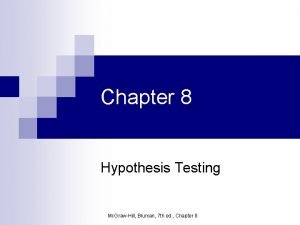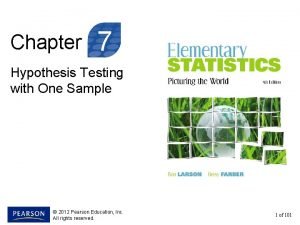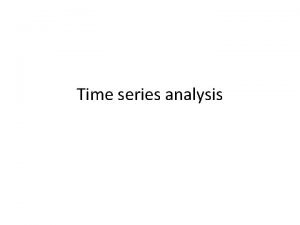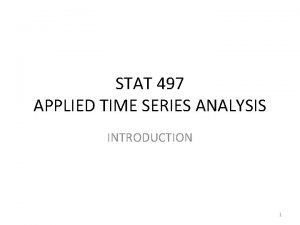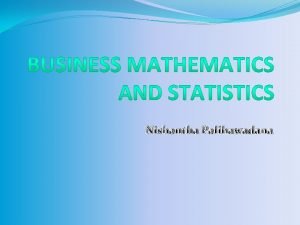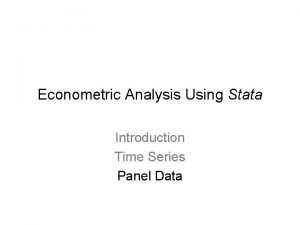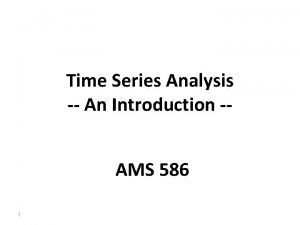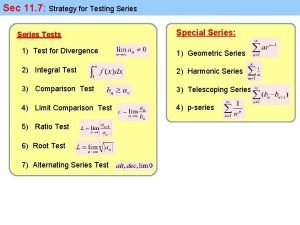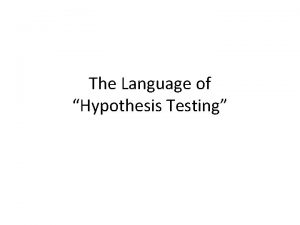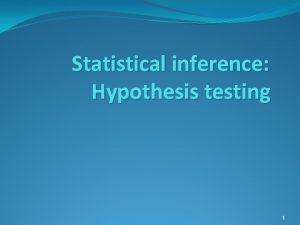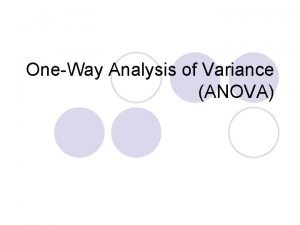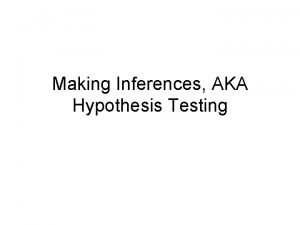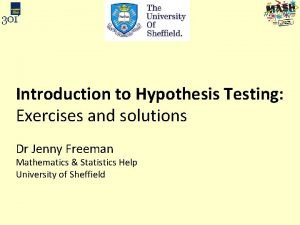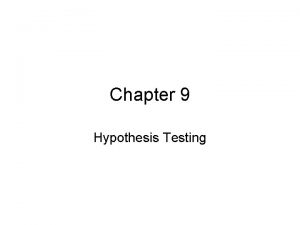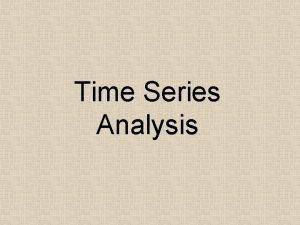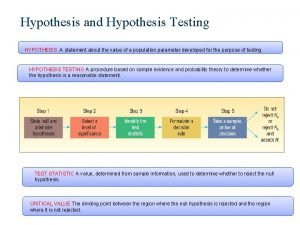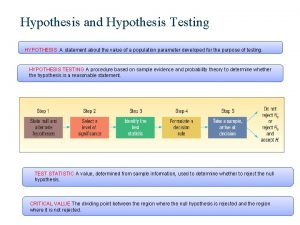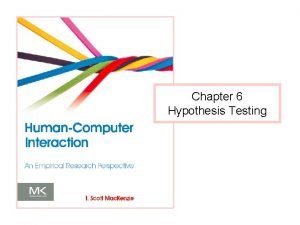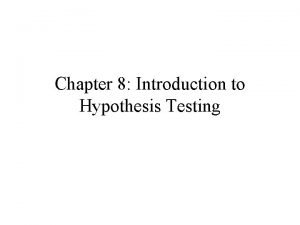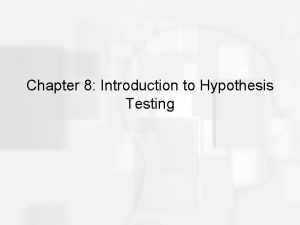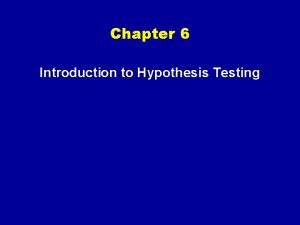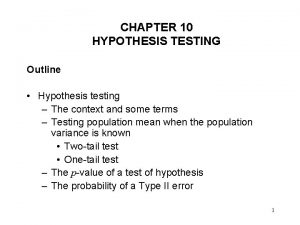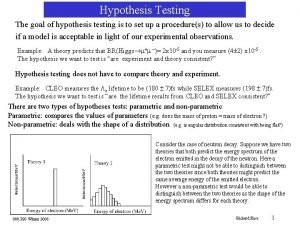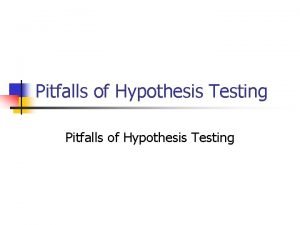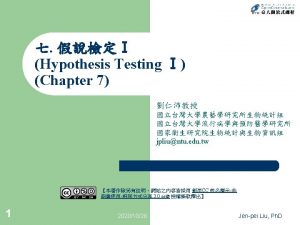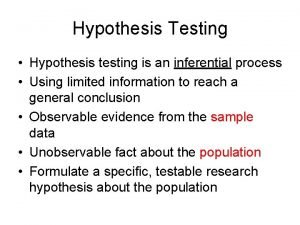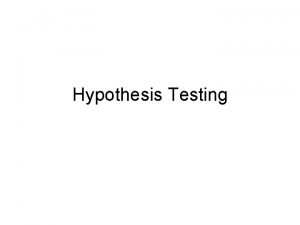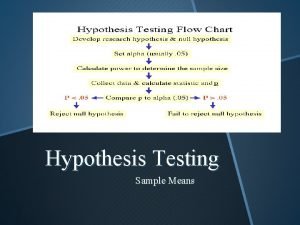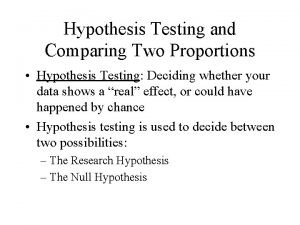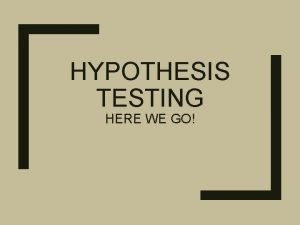Time Series Analysis Chapter 4 Hypothesis Testing Hypothesis









































- Slides: 41

Time Series Analysis – Chapter 4 Hypothesis Testing Hypothesis testing is basic to the scientific method and statistical theory gives us a way of conducting tests of scientific hypotheses. Scientific philosophy today rests on the idea of falsification: For a theory to be a valid scientific theory it must be possible, at least in principle, to make observations that would prove theory false. For example, here is a simple theory: All swans are white

Time Series Analysis – Chapter 4 Hypothesis Testing All swans are white This is a valid scientific theory because there is a way to falsify it: I can observe one black swan and theory would fall. For more information on the history and philosophy of falsification I suggest reading Karl Popper.

Time Series Analysis – Chapter 4 Hypothesis Testing Besides the idea of falsification, we must keep in mind the other basic tenant of the scientific method: All evidence that supports a theory or falsifies it must be empirically based and reproducible.

All evidence that supports a theory or falsifies it must be empirically based and reproducible. In other words, data! Just holding a belief (no matter how firm) that a theory is true or false is not a justifiable stance. This chapter gives us the most basic statistical tools for taking data or empirical evidence and using it to substantiate or nullify (show to be false) a hypothesis.

All evidence that supports a theory or falsifies it must be empirically based and reproducible. I have just used the word hypothesis and this chapter is concerned with hypothesis testing, not theory testing. This is because theories are composed of many hypotheses and, usually, a theory is not directly supported or attacked but one or more of it’s supporting hypotheses are scrutinized.

Discrimination or Not Activity Null Hypothesis Ho: No Discrimination Alternative Hypothesis Ha: Discrimination How do we choose which hypothesis to support?

Discrimination or Not Activity Null Hypothesis Ho: No Discrimination Alternative Hypothesis Ha: Discrimination How do we choose which hypothesis to support?

The p-value • p-value measures amount of support for alternative hypothesis. • The smaller the p-value the more support for the alternative hypothesis. • Typical level of support is 5% or 0. 05

Fourth Graders Feet Data Set

Fourth Graders Feet Data Set – Minitab Output Predictor variable (x): Childs Age Response variable (y): Foot Length The regression equation is Foot Length = 18. 1 + 0. 0358 Childs Age Predictor Coef SE Coef T P Constant 18. 138 3. 753 4. 83 0. 000 Childs Age 0. 03575 0. 02922 1. 22 0. 229

Fourth Graders Feet Data Set – Minitab Output

Fourth Graders Feet Data Set – One Tailed Alternative

Statistical vs. Practical Significance 401 K data set Predictor variables x 1: mrate x 2: age x 3: totemp Response variable (y): prate

Statistical vs. Practical Significance The regression equation is: prate = 80. 3 + 5. 44 mrate + 0. 269 age - 0. 000130 totemp Predictor Coef SE Coef T P Constant 80. 2943 0. 7777 103. 25 0. 000 mrate 5. 4414 0. 5244 10. 38 0. 000 age 0. 26941 0. 04515 5. 97 0. 000 totemp -0. 00012978 0. 00003672 -3. 53 0. 000

Statistical vs. Practical Significance The regression equation is: prate = 80. 3 + 5. 44 mrate + 0. 269 age - 0. 000130 totemp All predictors are statistically significant.

Statistical vs. Practical Significance The regression equation is: prate = 80. 3 + 5. 44 mrate + 0. 269 age - 0. 000130 totemp If total number of employees increases by ten thousand then participation rate decreases by 0. 000130*10, 000 = 1. 3% (other predictors held constant)

Boeing 747 Jet What does an empty Boeing 747 jet weigh?

Boeing 747 Jet What does an empty Boeing 747 jet weigh? My point estimate: 250, 000 lbs Answer: 358, 000 lbs I am wrong! A point estimate is almost always wrong!

Boeing 747 Jet What does an empty Boeing 747 jet weigh? My confidence interval estimate: (0, ∞) Answer: 358, 000 lbs I am right! But, my interval is not useful!

Point and Interval Estimates – Minitab will compute both 401 K data set Predictor variables x 1: age Response variable (y): prate In Minitab go to Regression -> General Regression and select the correct model variables then click on the Results box and make sure the “Display confidence intervals” box is selected.

Point and Interval Estimates – Minitab will compute both 401 K data set Predictor variables x 1: age Response variable (y): prate Regression Equation prate = 83. 4231 + 0. 298893 age Coefficients Term Coef SE Coef T P 95% CI Constant 83. 4231 0. 737593 113. 102 0. 000 (81. 9763, 84. 8699) age 0. 2989 0. 045938 6. 506 0. 000 ( 0. 2088, 0. 3890)

Confidence Intervals

Confidence Intervals

Confidence Intervals

Confidence Intervals Where does 1. 960 come from? t distribution with n – k – 1 degrees of freedom where k is the number of predictors in the model. For our model, n = 1533 and k = 1 We also need to know the confidence level of the interval (typically 95%) Then, use a t table!

Testing Linear Combinations of Parameters TWOYEAR data set Predictor variables x 1: jc – # years attending a two-year college x 2: univ – # years attending a four-year college x 3: exper – months in workforce Response variable (y): log(wage)

Testing Linear Combinations of Parameters

Testing Linear Combinations of Parameters

Testing Linear Combinations of Parameters

Testing Linear Combinations of Parameters

Testing Linear Combinations of Parameters



Testing Linear Combinations of Parameters

The ANOVA F Test

Multiple Linear Regression Assumptions

Multiple Linear Regression Assumptions MLR Assumption 2: Data comes from a random sample

Multiple Linear Regression Assumptions MLR Assumption 3: None of the independent or predictor variables are perfectly correlated (if they were, Minitab would not run a regression analysis).

Multiple Linear Regression Assumptions MLR Assumption 4: The error, u, has an expected value of zero.

Multiple Linear Regression Assumptions MLR Assumption 5: The error, u, has the same variance given any values of the explanatory variables. This is the assumption of homoskedasticity.

Multiple Linear Regression Assumptions
 Chapter 8 hypothesis testing
Chapter 8 hypothesis testing Chapter 7 hypothesis testing with one sample answers
Chapter 7 hypothesis testing with one sample answers What are the objectives of time series analysis?
What are the objectives of time series analysis? Strong stationarity
Strong stationarity Sequence definition
Sequence definition Time series analysis using stata
Time series analysis using stata Importance of time series
Importance of time series Components of time series
Components of time series Pooled time series cross-section analysis
Pooled time series cross-section analysis Start time, end time and elapsed time
Start time, end time and elapsed time Maclaurin series vs taylor series
Maclaurin series vs taylor series Heisenberg 1925 paper
Heisenberg 1925 paper Taylor series of composite functions
Taylor series of composite functions Maclaurin series vs taylor series
Maclaurin series vs taylor series Ibm p series server
Ibm p series server Series shunt feedback
Series shunt feedback Series aiding and series opposing
Series aiding and series opposing Arithmetic series formula
Arithmetic series formula Strategies for testing series
Strategies for testing series What is domain
What is domain Kv charts in software testing
Kv charts in software testing Data flow testing strategies in software testing
Data flow testing strategies in software testing Positive and negative testing
Positive and negative testing Cs 3250
Cs 3250 Anuj magazine
Anuj magazine Neighborhood integration testing
Neighborhood integration testing Language testing
Language testing Control structure testing in software testing
Control structure testing in software testing Decision table testing in software testing
Decision table testing in software testing Decision table advantages and disadvantages
Decision table advantages and disadvantages Error yang dapat diketahui dari pengujian black box adalah
Error yang dapat diketahui dari pengujian black box adalah Behavior testing adalah
Behavior testing adalah Decision table for triangle problem
Decision table for triangle problem Rigorous testing in software testing
Rigorous testing in software testing Testing blindness in software testing
Testing blindness in software testing Component testing is a black box testing
Component testing is a black box testing Types of domain testing
Types of domain testing The language of hypothesis testing
The language of hypothesis testing P value significant difference
P value significant difference Anova hypothesis
Anova hypothesis Hypothesis testing assignment
Hypothesis testing assignment Hypothesis testing
Hypothesis testing
